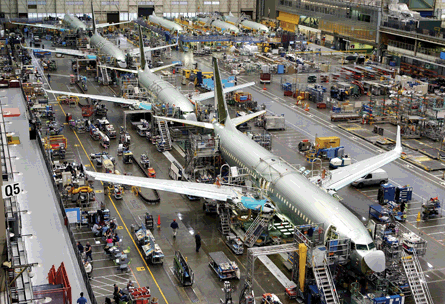Boeing chief executive Jim McNerney believes a re-engined narrowbody is viable in the near term because of the progress made by engine manufacturers.
McNerney told attendees at the Morgan Stanley Global Industrials Unplugged Conference in New York in early September that General Electric, Pratt & Whitney and Rolls-Royce "have some pretty good engines there".
Boeing and arch-rival Airbus maintain that engine technology has been an important driver in any decision concerning the narrowbody market, as both airframers seek to deliver 15-20% efficiency gains for operators.
McNerney believes that a derivative re-engined 737 would cost in the range of 20-30% of a full development programme.
 |
|---|
© Rex Features |
As a result, he says, "the re-engine case is stronger than I anticipated it would be, which doesn't mean that that's what we'll decide".
Re-engining is a widely discussed possibility for both the A320 and 737, but neither airframer has made any commitments beyond delivering incremental improvements in efficiency.
As Airbus and Boeing have looked at their respective next steps towards a narrowbody replacement, the targets for entry into service have slid continually to the right.
Three years ago, both airframers entertained mid-decade availability for next-generation narrowbody products, but the timeframe has moved to 2020 or beyond at the earliest, with neither side being the one to blink first.
McNerney guesses "that Boeing and Airbus will jockey for position. Who goes first will depend less on a cute strategy and more on who matures the technologies they need."
If Boeing decides to "go with a composite fuselage based on our lead and being able to manage composites, and think we can get there first, we may decide to go first. Engine technology will probably be a push," McNerney says, and airframe technology could be a discriminator, he adds.
Referencing the two years of delays endured by Boeing on the 787, McNerney says: "We've learned the hard way on how to design and build composites."
But he believes Boeing's composite experience is "really going to pay off when we re-do the 777 and when we take a look at the narrowbody. It's the bleeding edge - eventually, the innovator's advantage will come back to us. Right now it hurts like hell."
Pratt & Whitney is developing the PurePower PW1000G geared turbofan engine for entry into service in 2013 on Mitsubishi's MRJ regional jet and later on the Bombardier CSeries small airliner, the closest competitor to Boeing's 737.
 |
|---|
© Pratt & Whitney |
The General Electric-Snecma joint venture CFM is developing the Leap-X engine scheduled for service readiness by 2016 and has not yet been selected by an aircraft manufacturer.
Rolls-Royce, while not committing to a new narrowbody engine programme, has explored developments that could see increases in engine core temperature that reduce time on wing between overhauls, but deliver overall operating cost savings through improved fuel efficiency.
Source: Flight International
















